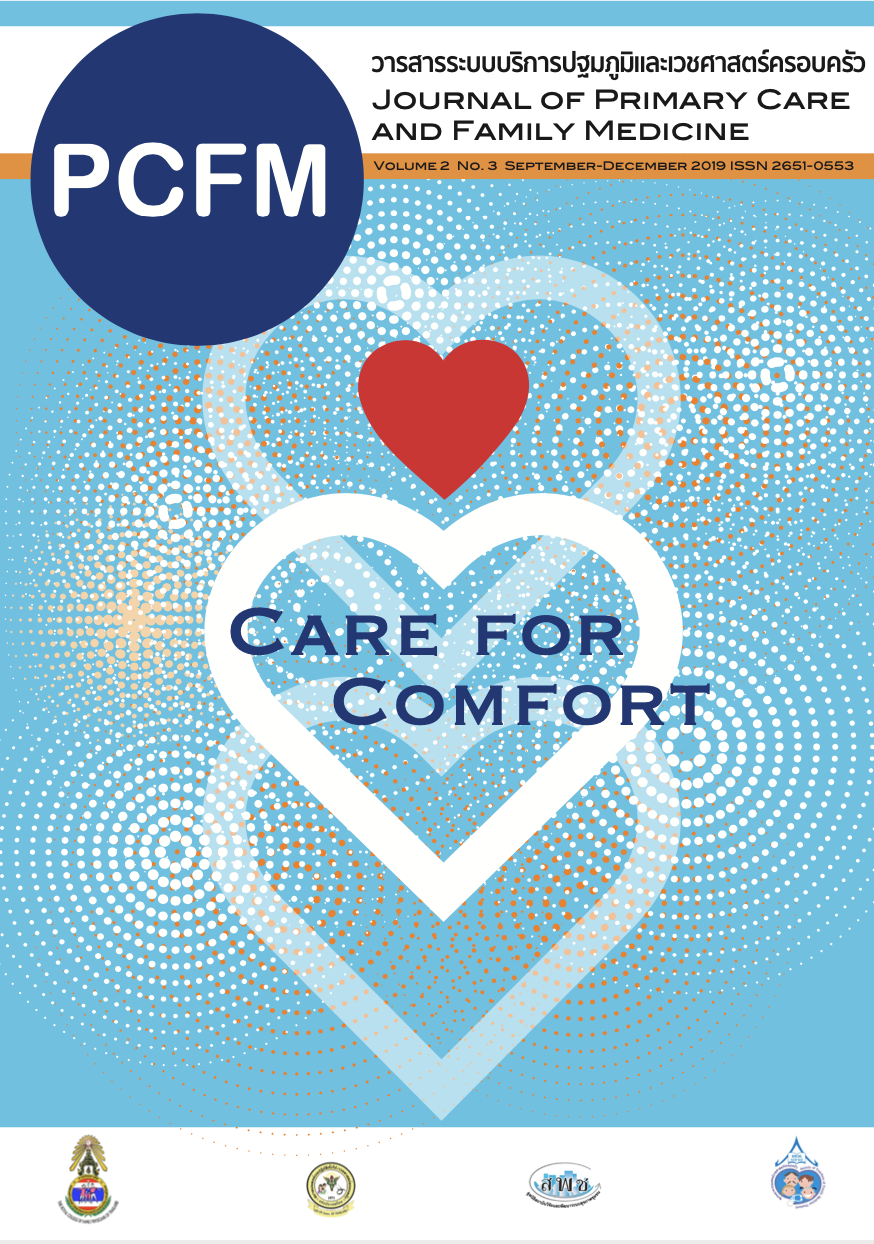ทัศนคติและความต้องการของผู้ดูแลในการดูแลผู้ป่วยมะเร็งแบบประคับประคอง ณ โรงพยาบาลพระมงกุฎเกล้า
Main Article Content
บทคัดย่อ
บทคัดย่อ
วัตถุประสงค์: ศึกษาทัศนคติและความต้องการของผู้ดูแลในการดูแลผู้ป่วยมะเร็งแบบประคับประคอง
แบบวิจัย: การศึกษาแบบผสมผสานร่วมกัน
วัสดุและวิธีการ: ผู้ดูแลผู้ป่วยมะเร็งแบบประคับประคองจำนวน 25 คน ระหว่างเดือนมีนาคมถึงพฤษภาคม 2562 โดยการสัมภาษณ์กึ่งโครงสร้าง 3 ประเด็น คือ (1) เหตุผลและความคิดเห็นในการดูแลผู้ป่วย (2) ปัญหาและความต้องการของผู้ดูแลในการดูแลผู้ป่วย (3) การแก้ปัญหาเบื้องต้นของผู้ดูแล ข้อมูลถูกเข้ารหัสและวิเคราะห์โดยใช้วิธีการวิเคราะห์เฉพาะประเด็น ผู้เขียนได้ศึกษาลักษณะทางประชากรศาสตร์ของผู้ดูแลผู้ป่วยรวมทั้งปัญหาและปัญหาและความต้องการการดูแลแบบประคับประคองโดยใช้แบบสอบถามความต้องการการดูแลแบบประคับประคองของผู้ดูแล (The Problems and Needs in Palliative Care Questionnaire-caregiver form: PNPC-c) ฉบับภาษาไทย และวิเคราะห์ข้อมูลทัศนคติและการแก้ปัญหาโดยใช้สถิติพรรณนา
ผลการศึกษา: อายุเฉลี่ยของผู้ดูแลเท่ากับ 52.45 ปี มีบทบาทในการดูแลโดยเฉลี่ย 3.45 ปีและมากกว่าครึ่งหนึ่งใช้เวลาดูแลมากกว่า 12 ชั่วโมงต่อวัน โดยส่วนใหญ่จะมีผู้ช่วยดูแล จากการสัมภาษณ์พบว่าผู้ดูแลมีปัญหาในการดูแลแตกต่างกันไป โดยปัญหาที่พบมากที่สุดคือ ความกลัวต่ออนาคตที่ไม่แน่นอน ความเข้าใจในโรคของผู้ป่วย และปัญหาทางจิตใจและอารมณ์ตามลำดับ และมีแนวทางการแก้ไขปัญหาทั้งจากตนเองคือการหาวิธีผ่อนคลายความเครียด รวมไปถึงการได้รับการช่วยเหลือสนับสนุนจากผู้อื่น ครอบครัว และบุคลากรทางการแพทย์ทั้งข้อมูล ช่วยเหลือดูแล และดูแลสภาพจิตใจของผู้ดูแล
สรุป: ปัญหาของผู้ดูแลในการดูแลผู้ป่วยมีหลากหลายปัญหาที่อาจจะยังค้นพบ แนวทางการแก้ไขปัญหาสามารถแก้ไขได้โดยจากตัวผู้ดูแลเอง ความยืดหยุ่น ทัศนคติ สภาวะจิตใจ และการช่วยเหลือสนับสนุนจากผู้อื่น ครอบครัว และบุคลากรทางการแพทย์
คำสำคัญ: ผู้ดูแล, การดูแลแบบประคับประคอง, ความต้องการ, ปัญหาในการดูแล
Article Details
เนื้อหาและข้อมูลในบทความที่ลงตีพิมพ์ในวารสาร PCFM ถือเป็นข้อคิดเห็นและความรับผิดชอบของผู้เขียนบทความโดยตรง ซึ่งกองบรรณาธิการวารสารไม่จำเป็นต้องเห็นด้วยหรือร่วมรับผิดชอบใด ๆ
บทความ ข้อมูล เนื้อหา รูปภาพ ฯลฯ ที่ได้รับการตีพิมพ์ลงในวารสาร PCFM ถือเป็นลิขสิทธิ์ของวารสาร PCFM หากบุคคลหรือหน่วยงานใดต้องการนำทั้งหมดหรือส่วนหนึ่งส่วนใดไปเผยแพร่ต่อหรือเพื่อกระทำการใด ๆ จะต้องได้รับอนุญาตเป็นลายลักษณ์อักษรจากวารสาร PCFM ก่อนเท่านั้น
เอกสารอ้างอิง
1. World Health Organization. (2018), available from: http://www.who.int/cancer/en/
2.National Cancer Control Programmes 2556-2560. Available from:http://www.nci.go.th/
3.World Health Organization. (2002), available from: http://www.who.int/cancer/en/
4.Kuyper MB. On the background: a study of the problems of spouses of patients with chronic disease [Op de achtergrond, Een onderzoek naar de problemen van partners van patie¨nten met een chronische ziekte] [dissertation of the University Nijmegen, the Netherlands]. Amsterdam: Thesis Publishers; 1993.
5. Proot IM, Huijer Abu-Saad H, ter Meulen RHJ, Goldsteen M, Spreeuwenberg C, Widdershoven G. The needs of terminally ill patients at home: directing one’s life, health and things related to beloved others. Palliat Med. 2004;18(1):53Y61.
6. Sepulveda C, Marlin A, Yoshida T, Ullrich A. Palliative care: the World Health Organization’s global perspective. J Pain Symptom Manage. 2002; 24(2):91Y96.
7. Knodel J, Teerawichitchainan B, Prachuabmoh V, Pothisiri W. The Situation of Thailand’s Older Population : An update based on the 2014 Survey of Older Persons in Thailand. HelpAge International; 2015.
8. Foundation of Thai Gerontology Research and Development Institute (TGRI). Situation of the Thai elderly 2015. Bangkok: Amarin printing and publishing; 2016.
9. Schulz R, Beach SR. Caregiving as a risk factor for mortality: The Caregiver Health Effects Study. JAMA 1999; 282:2215-9.
10. Sihapark S, Chuengsatiansup K, Tengrang K. The effect and caregiving burdens of older persons in long-term care based on Thai culture. Health systems research institute. 2013.
11. Suphasiri Chiangta, Wallada Chanruangvanich , Orapan Thosingha, Phawin Keskool . Relationship between Head & Neck Cancer Patients and Their Caregivers in Terms of Palliative Care Needs . Thai Journal of nursing council. 2560
12. Proot IM, Abu-Saad HH, ter Meulen RH, Goldsteen M, Spreeuwenberg C, Widdershoven GA. The needs of terminally ill patients at home: Directing one’s life, health and things related to beloved others. Palliative Medicine 2004; 18: 53–61.
13. Hanks GW, Conno F, Cherny N et al. Morphine and alternative opioids in cancer pain: The EAPC recommendations. The British Journal of Cancer 2001; 84: 587–593.
14. Mystakidou K, Befon S, Kouskouni E et al. From codeine to transdermal fentanyl for cancer pain control: A safety and efficacy clinical trial. Anticancer Research 2001; 21: 2225–2230.
15. Mystakidou K, Parpa E, Tsilika E et al. Pain management of cancer patients with transdermal fentanyl: A study of 1828 step I, II, & III transfers. Journal of Pain 2004; 5: 119–132.
16. Addington-Hall JM, MacDonald LD, Anderson HR et al. Randomised controlled trial of effects of coordinating care for terminally ill cancer patients. BMJ (Clinical Research Ed.) 1992; 28: 1317–1322.
17. Wiggers JH, Donovan KO, Redman S, Sanson-Fisher RW. Cancer patient satisfaction with care. Cancer 1990; 66: 610–616.
18. Maguire P, Walsh S, Jeacock J, Kingston R. Physical and psychosocial needs of patients dying from colo-rectal cancer. Palliative Medicine 1999; 13: 45–50.
19. Miller K, Massie MJ. Depression and anxiety. Cancer Journal 2006; 12: 388–397.
20. Osse BH, Vernooij-Dassen MJ, Schadé E, Grol RP. Problems experienced by the informal caregivers of cancer patients and their needs for support. Cancer Nursing 2006; 29: 378–388.
21. Cohen SR, Mount BM, Strobel MG, Bui F. The McGill Quality of Life Questionnaire: a measure of quality of life appropriate for people with advanced disease. A preliminary study of validity and acceptability. Palliative Medicine 1995; 9: 207–219.
22. Connell CM, Gibson GO. Racial, ethnic, and cultural differences in dementia caregiving: review and analysis. Gerontologist 1997; 37(3): 355-364.
23. Beach SR, Schulz R, Yee JL, Jackson S. Negative and positive health effects of caring for a disabled spouse:longitudinal findings from the Caregiver Health Effects Study. Psychol Aging 2000; 15(2): 259-271.
24. Schulz R, Newsom J, Mittelmark M, Burton L, Hirsch C, Jackson S. Health effects of caregiving: the caregiver health effects study: an ancillary study of the Cardiovascular Health Study. Ann Behav Med 1997; 19(2): 110-116.
25. Schulz R, Beach SA. Caregiving as a risk factor for mortality: the Caregiver Health Effects Study. JAMA 1999;282(23): 2215-2219.
26. Covinsky KE, Goldman L, Cook EF, Oye R, Desbiens N, Reding D, et al. The impact of serious illness on patients' families. JAMA 1994; 272(23): 1839-1844.
27. Maguire P, Walsh S, Jeacock J, Kingston R. Physical and psychosocial needs of patients dying from colo-rectal cancer. Palliat Med. 1999,13(1):45Y50.
28. Hinton J. Can home care maintain an acceptable quality of life for patients with terminal cancer and their relatives? Palliat Med. 1994;8:183Y196.
29. Norman G. Hi! How are you? Response shift, implicit theories and differing epistemologies. Qual Life Res. 2003;12(3):239Y249.
30. Vess JD, Moreland JR, Schwebel AI, Kraut E. Psychosocial needs of cancer patients: learning from patients and their spouses. J Psychosoc Oncol. 1988;6:31Y51.


